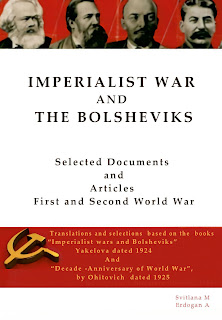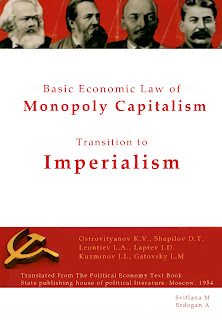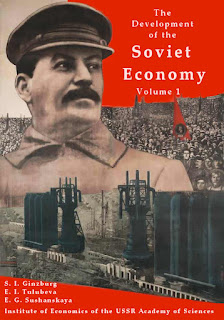On Trotskyism- Primitive Socialits Accumulation and problems of transition - Mavrakis
Mavrakis
PRIMITIVE SOCIALIST ACCUMULATION AND PROBLEMS OF THE TRANSITION
Deutscher says of this concept: 'The Marxist historian may indeed describe and analyse those decades, the Stalinist decades, as the era of primitive socialist accumulation; and he may do so in terms borrowed from Trotsky's exposition of the ideas in 1923.'(25) Lenin described the expression 'primitive socialist accumulation', which was coined by Smirnov at the time of war communism and taken up by Bukharin in 'The Economy of the Transition Period', as a 'very unfortunate' expression and 'a copy of schoolboy terms'. It was propagated by Trotsky in a different context from 1922 on. Preobrazhensky theorised it in 'The New Economics', published in 1925.
Here is how the latter author justified the petinence of his analogy:(26)
Just as the functioning of manufactures and still more of factories with machine techniques, so also for enabling the complex of state economy to develop all its economic advantages and to place itself under a new technical basis, a certain minimum of previously accumulated means in the form of natural elements of production is needed.
Setting out Trotsky's ideas on the same problem, Isaac Deutscher defines Marx's view of primitive accumulation as follows:(27)
The era of primitive accumulation (was) the initial phase in the development of modern capitalism when normal accumulation of capital had hardly begun or was still too feeble to allow industry to expand from its own resources, that is from its own profits. The early bourgeoisie shrank from no violent, 'extra- economic' method in its striving to concentrate in its whole hands the means of production.
In 1922 Trotsky said: 'The proletariat . . . is compelled to embark upon a phase which may be described as that of primitive socialist accumulation. We cannot content ourselves with using our pre-1914 industrial plant. This has been destroyed and must be reconstructed step by step by way of a colossal exertion on the part of our labour force.' And again, the working class 'can approach socialism only through the greatest sacrifices, by straining all its strength and giving its blood and nerves'.(28)
These three quotations demonstrate that there is a theoretical contradiction underlying the comparison with the primitive accumulation discussed by Marx. The latter defined it like this: 'The so-called primitive accumulation, therefore, is nothing else than the historical process of divorcing the producer from the means of production'.(29) Initially Marx had stressed the fact that 'In themselves money and commodities are no more capital than are the means of production and of subsistence. They want transforming into capital.'(30)
This is an idea which constantly recurs in his 'magnum opus': 'Capital is not a thing but a social relation between persons, established by the instrumentality of things.'(31)
Marx gave the example of Mr Peel who took with him from England to Australia means of production worth £50,000 and 3,000 workers. Once he had reached his destination he was left without a servant to make his bed or to fetch him a glass of water. 'Unhappy Mr Peel,' Marx concluded, 'who provided for everything except the export of English modes of production to Swan River!'(32)
Trotsky, Preobrazhensky and Deutscher make the same mistake. They do not understand that primitive accumulation is only the historical process of the creation of capitalist relations of production and not simply the accumulation of 'the natural elements of production' (Preobrazhensky) or 'industrial plant' (Trotsky). For writers who pride themselves on their 'classical Marxism', this is not without irony.
It is now clear that the historical analogy implied in the expression 'primitive socialist accumulation' is totally illegitimate.
Our purpose is not to discuss in detail Preobrazhensky's economic theory, that is, not the expression, but the concept. It is enough to point out that Trotsky proved much less consistent than Preobrazhensky on this question. Preobrazhensky argued that in a predominantly agricultural country the bulk of investment funds in the socialist industrial sector would come from the surplus agricultural product and that accelerated industrialisation could only be realised by means of a transfer of value from the countryside to the town. It is doubtful whether this form of exploitation was compatible with the raising of the peasants' standard of living. Although basically sharing Preobrazhensky's views, Trotsky feared that he would be accused of advocating the exploitation of the peasantry and refrained from openly adopting them. The concept of primitive accumulation was useful to him anew fifteen years later in 'The Revolution Betrayed'.
We have shown that Trotsky's and Preobrazhensky's notion of the primitive accumulation of capital was not a Marxist one. It is not surprising to discover that the primitive 'socialist' accumulation which they talk about is precisely not socialist.
On the one hand, the socialisation of the economy cannot be likened to the separation of the producers from their means of production which, on the contrary, they come to own collectively through their control of state power. Of course, in so far as the units of production function as enterprises they reproduce the pattern of the double separation of the immediate producers from their means of production and of the units from each other. However, that is a problematic only attained by Charles Bettelheim in his latest works and one whose existence Trotsky did not even suspect. Moreover, the latter regarded the tendency to primitive accumulation as a law of the transition, which the example of China disproves.
On the other hand, the comparison of the primitive accumulation of a supposed socialism with that of capitalism is significant and legitimate in a certain sense. The model of construction of socialism proposed by Preobrazhensky assumes that it will be realised mainly starting from the towns thanks to the resources freed by maintaining poverty in the countryside, and by relying on techniques and methods of labour organisation which have given the best results in the advanced countries, and copied as such. This sort of accumulation or expanded reproduction reproduces at the same time relations of production of the capitalist type. Like Preobrazhensky, Stalin thought that it was necessary to levy a 'tribute' on the peasants (cf. his report to the Central Committee in July 1928); just like the Trotskyist theoretician, he identified the construction of socialism purely and simply with the development of a large-scale modern industry based on giant, highly productive units. This 'economistic' idea prevailed for a long time, even to a certain extent in China. Today it is the common heritage of Trotskyists and revisionists as well as the common ground between them and the traditional bourgeois specialists.
Stalin and Trotsky identified the construction of socialism with a mere increase in the productive forces, themselves reduced to machines, the human factor being eliminated. They did not see that after the abolition of the individual ownership of the means of production the essential remains to be done - to revolutionise the relations of production and all the social relations connected to them. They suspected even less the dialectical interaction between these transformations and the development of specifically socialist productive forces. Assembly-line work, the parcellisation of tasks, the conception of the machines, the capitalist organisation of production, presuppose a recalcitrant labour force which submits unwillingly and passively to wage slavery. Taylorism aims to extract the maximum from workers by making them simple appendages of machines devoid of will. The authoritarian relationships in the factory, the type of discipline which rules it, the gulf between intellectual and manual work are equally necessary conditions for exploitation. On the other hand, the productive forces proper to socialism are based on the initiative and creativity of the masses, their enthusiasm, their ingenuity, their self-discipline and their self-education. The Anchan Charter drawn up by Mao in 1960 takes the opposite course to that of Magnitogorsk, which was held up as an example to Soviet industry at the time of the First Five-Year Plan because this latter charter was inspired by capitalist organisation of labour.
The experience of the Great Leap Forward and the cultural revolution enabled the guidelines of a different model to be established. In China the Maoist principle is applied - 'Make the revolution and promote production'. The creation of 'the material basis of socialism' is subordinated there to the destruction of the social relations inherited from capitalism which are replaced by socialist relations. In turn, the socialist relations call forth new productive forces which are proper to socialism. Thanks to the people's communes, the small rural industries, and the principles 'stand on both feet' and 'self-reliance', this process of ideological, political and economic revolutionisation is developing on a very wide basis and transforming the whole country.(33) In their practice, the Chinese workers consciously confirm the thesis already stated by Marx: 'The working class itself is the greatest of all productive forces.'




























.jpg)




















